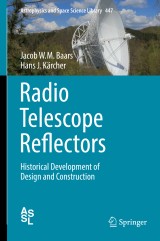Details

Radio Telescope Reflectors
Historical Development of Design and ConstructionAstrophysics and Space Science Library, Band 447
|
160,49 € |
|
| Verlag: | Springer |
| Format: | |
| Veröffentl.: | 18.11.2017 |
| ISBN/EAN: | 9783319651484 |
| Sprache: | englisch |
Dieses eBook enthält ein Wasserzeichen.
Beschreibungen
This book demonstrates how progress in radio astronomy is intimately linked to the development of reflector antennas of increasing size and precision. The authors describe the design and construction of major radio telescopes as those in Dwingeloo, Jodrell Bank, Parkes, Effelsberg and Green Bank since 1950 up to the present as well as millimeter wavelength telescopes as the 30m MRT of IRAM in Spain, the 50m LMT in Mexico and the ALMA submillimeter instrument. The advances in methods of structural design and coping with environmental influences (wind, temperature, gravity) as well as application of new materials are explained in a non-mathematical, descriptive and graphical way along with the story of the telescopes. Emphasis is placed on the interplay between astronomical and electromagnetic requirements and structural, mechanical and control solutions. A chapter on management aspects of large telescope projects closes the book. The authors address a readership with interest in the progress of engineering solutions applied to the development of radio telescope reflectors and ground station antennas for satellite communication and space research. The book will also be of interest to historians of science and engineering with an inclination to astronomy.<p></p><p></p>
<p>Introduction.- Evolution of the Telescope.- Birth of Radio Astronomy.- Structural Design of Reflector Antennas - Homology.- Emergence of Millimeter-wavelength Telescopes.- Submillimeter-wavelength Telescopes.- Alternative Reflector Geometries.- Electromagnetic Aspects of the Reflector Antenna.- Design and Optimization methods.- Verification - Surface and Pointing Measurement methods.- Realization.</p>
<div><p>Jacob W. M. Baars obtained the Ir- and Dr. Ir.-degrees in physics from the Technical University Delft in 1963 and 1970, respectively. After a three year stint at the National Radio Astronomy Observatory (USA) he joined the Netherlands Foundation for Radio Astronomy in 1966. There he participated in the construction and commissioning of the Westerbork Synthesis Radio Telescope and directed its operation from 1972. Upon moving to the Max-Planck-Institut für Radioastronomie in Bonn in 1975, he was project manager of two advanced millimeter wave radio telescope projects – the IRAM mm-telescope on Pico Veleta, Spain and the Heinrich Hertz Telescope on Mt. Graham, Arizona, USA. He served as Project Scientist during the definition and design phase of the Large Millimeter Telescope of Mexico/University of Massachusetts. In 1999 he joined the ALMA group at the European Southern Observatory in Garching, where he performed tasks in management, system engineering and in particular the design, construction and evaluation of two prototype submillimeter radio telescopes. Since his retirement he has acted as consultant to radio telescope projects and participated in project review committees, in particular the Square Kilometre Array.</p><p>Hans Jürgen Kärcher obtained the Dipl.Ing. and Dr.-Ing. degrees in structural and mechanical engineering from the Technical University in Darmstadt in 1968 and 1974, respectively. He joined MAN Gustavsburg, (now MT Mechatronics) in 1974, initially as system engineer for telescopes and communication antennas. From 1986 up to retirement in 2006 he was head of research and development programs. From 2006 to now he is consultant for telescope mechanics, associated with MT Mechatronics, Mainz. He was project manager and/or lead system engineer for about 40 major telescope projects, optical as well as radio. Highlights were e.g. the 30m Millimeter Radio Telescope MRT IRAM in Spain, the 50m Large Millimeter Telescope LMT/GTM in Mexico, the 2.7mStratospheric Observatory for Infrared Astronomy SOFIA in the US, and the 4m Advanced Solar Telescope ATST/DKIST on Maui, Hawaii.<br/></p></div><div><br/></div>
<p>This book demonstrates how progress in radio astronomy is intimately linked to the development of reflector antennas of increasing size and precision. The authors describe the design and construction of major radio telescopes as those in Dwingeloo, Jodrell Bank, Parkes, Effelsberg and Green Bank since 1950 up to the present as well as millimeter wavelength telescopes as the 30m MRT of IRAM in Spain, the 50m LMT in Mexico and the ALMA submillimeter instrument. The advances in methods of structural design and coping with environmental influences (wind, temperature, gravity) as well as application of new materials are explained in a non-mathematical, descriptive and graphical way along with the story of the telescopes. Emphasis is placed on the interplay between astronomical and electromagnetic requirements and structural, mechanical and control solutions. A chapter on management aspects of large telescope projects closes the book. The authors address a readership with interest in theprogress of engineering solutions applied to the development of radio telescope reflectors and ground station antennas for satellite communication and space research. The book will also be of interest to historians of science and engineering with an inclination to astronomy.<br/></p><p></p>
Presents the history of design and construction of radio telescopes over the last 80 years, illustrated by descriptions of the major telescopes Discusses advances in design and technology by detailed examination of telescopes up to the recently completed instruments for millimetre wavelength astronomy Includes the basics of homology design, thermal control, wind effects, as well as the use of advanced materials for millimeter wavelength telescopes Concludes with comments on the practical realisation of large telescope projects
<p>Presents the history of design and construction of radio telescopes over the last 80 years, illustrated by descriptions of the major telescopes</p><p>Discusses advances in design and technology by detailed examination of telescopes up to the recently completed instruments for millimetre wavelength astronomy</p><p>Includes the basics of homology design, thermal control, wind effects, as well as the use of advanced materials for millimeter wavelength telescopes</p><p> </p><p>Concludes with comments on the practical realisation of large telescope projects</p>

















